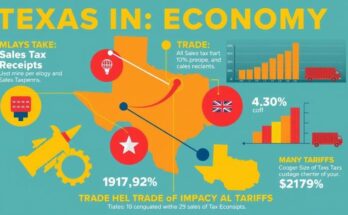President Donald Trump’s characterisation of his latest tariff announcement as “Liberation Day” rings ironically, as it appears to liberate families from their finances. What began as a steady economic upturn quickly spiralled into chaos, marked by plummeting consumer confidence, stagnant business investment, and escalating job losses. The fallout of Trump’s tariffs, instead of fostering growth, has resulted in an economic downturn that seems self-inflicted, highlighting his lack of strategic foresight.
The president’s assertion that tariffs will curtail imports while also generating significant income raises eyebrows. His blanket minimum tariff of 10% and rates up to 50% lack justification and do not effectively address unfair trading practices. For instance, the European Union faces a staggering 20% tariff on their minimal rates compared to America’s pre-2025 rate. Such disproportionate tariffs reveal a lack of strategy, with countries like Canada facing similar unjust treatment despite historically aligned trade agreements.
In trying to hark back to a bygone economic era, Trump overlooks the lessons of history. The tariffs reminiscent of the 1890 McKinley tariffs led to a devastating depression shortly thereafter. His efforts echo the disastrous Smoot-Hawley tariff law, which exacerbated the Great Depression. Current tariffs are higher than any observed in the modern industrial age, casting a shadow over America’s trading prospects.
Trump’s tariffs are often touted as responses to trade deficits, which he fails to comprehend accurately. A misunderstanding leads him to claim a $200 billion burden from Canada, when the real number is $64 billion. Trade deficits do not equate to subsidies; they represent consumer choices that result in beneficial capital inflow, such as investments in U.S. bonds. Tariffs are unlikely to transform this dynamic and may instead deepen economic strife through hindered consumer demand.
Manufacturing jobs, despite the narrative, are affected more by automation than foreign competition. While there may be a modest rebound in numbers through onshoring, these jobs will likely come with worse pay and conditions. It raises the moral conundrum of forcing Americans to pay significantly higher prices for goods, which devastates millions of export jobs.
Even industries like automotive manufacturing, which is heavily reliant on imported components, face the brunt of Trump’s tariffs, leading to anticipated losses. If the economic lifeblood of these tariffs—the American manufacturing sector—stands to suffer, the question arises: who truly benefits from these policies?
These tariffs effectively become an additional burden on consumers, as businesses invariably pass on the costs. Historical instances reveal that tariff-induced price spikes immediately burden average households. The administration’s neglect of these realities can lead to price inflation on everyday goods, making life harder for economically vulnerable Americans.
Estimates suggest that if retaliatory tariffs were to clash, the median-earning family could see a loss of nearly $4,000. The anticipated budget increases from tariffs are unlikely, as reduced demand may render such revenue projections implausible. After all is said and done, the harm inflicted upon the economy far outweighs any minimal gain, leaving America worse off.
Today’s generations appear poised to repeat the blunders of history. Immersed in overly simplistic rhetoric against outsourcing, they may neglect the wisdom derived from past lessons. However, a glimmer of hope shines through public sentiment, with rising support for international trade. As C.S. Lewis aptly noted, experience is a brutal teacher, but it also imparts invaluable lessons that count—”my God do you learn.”
President Trump’s tariffs, dubbed “Liberation Day,” have been marked by economic instability—plummeting consumer confidence, rising job losses, and a stagnant market. The tariffs are seen as self-inflicted wounds on a once-thriving economy, implemented without coherent strategy or justification. Misunderstandings about trade deficits further complicate the economic implications, leading to increased consumer prices and potential job losses. America’s manufacturing sector, reliant on imported components, suffers significantly, raising concerns about the overall benefit of these policies. Support for international trade is growing as a counterpoint to the current tariff strategy.
In sum, President Trump’s tariffs appear misguided and counterproductive, further exacerbating an already shaky economic landscape. Instead of protecting American jobs and stimulating growth, they risk inflating consumer prices, inducing job losses, and deepening trade deficits. The tariffs not only lack a coherent strategy but also echo historical mistakes that once led to severe economic downturns. As such, the trajectory toward a more isolationist trade policy seems fraught with peril, sparking a need for a reconsideration of America’s approach to global trade.
Original Source: www.msnbc.com



